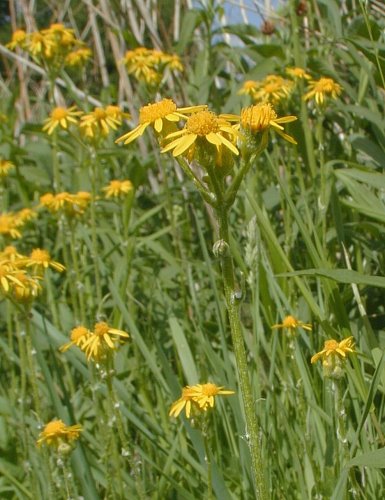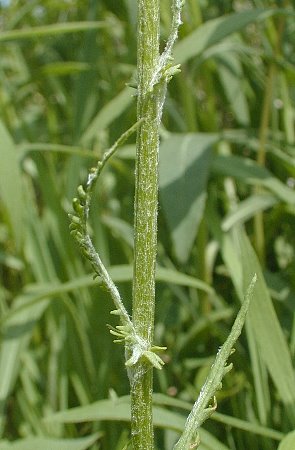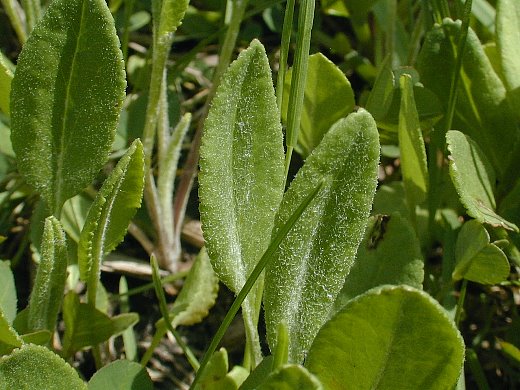Description: This wildflower is a biennial or short-lived perennial plant that is ½–1' tall when it blooms. The basal leaves persist during most of the year, although they may die down during the winter. They are ¾-2" long, ½-1" across, broadly elliptic to oval-obovate in shape, and either finely serrated or slightly dentate along their margins. The slender petioles of the basal leaves are ½-1" long and light green; they often have cobwebby hairs. The blade surface of the basal leaves is medium green and sparsely covered with mealy hairs. Unbranched flowering stalks develop among the basal leaves. These stalks are light green, terete to slightly channeled, and more or less covered with cobwebby hairs. Alternate leaves are sparsely distributed along each flowering stalk; they are up to 1¼" long and ¼" across. The alternate leaves are medium green, narrowly pinnatifid, and more or less covered with cobwebby hairs, particularly along the lower side of their central veins and along their petioles.

The central stalk terminates in a flat-headed cluster of 3-12 flowerheads. Each daisy-like flowerhead is about ½" across, consisting of 8-14 ray florets surrounding numerous disk florets that are yellow or golden yellow. The petaloid rays of the flowerheads are yellow and narrowly oblong. Around the base of each flowerhead, there are light green floral bracts (phyllaries) that are arranged together in a single series. They are oblong-linear in shape and more or less covered with cobwebby hairs. The blooming period occurs from mid- to late spring, lasting about 3-4 weeks. The flowerheads are mildly fragrant. About a month after the blooming period, the achenes mature, developing tufts of white hairs; they are dispersed by the wind. The root system is fibrous and rhizomatous. Prairie Ragwort often forms clonal colonies from its rhizomes.

Cultivation:
The preference is full sun, mesic to dry conditions, and soil
containing loam, clay-loam, sand, or gravelly material. Prairie Ragwort
tends to favor less fertile soil because of the reduced competition
from other plants. The basal leaves are semi-evergreen and they have
few problems with disease.
Range & Habitat:
The native Prairie Ragwort occurs primarily in the northern half of
Illinois and in counties that are located along major rivers. It is
occasional to locally common in the northern and
western sections of the state, while elsewhere it is uncommon or absent
(see Distribution
Map).
Habitats include upland prairies, gravel prairies, sand prairies, hill
prairies, bluffs overlooking major rivers, openings in either
rocky or sandy upland forests, sandy savannas, limestone glades,
and roadside embankments. This little plant is usually found in open
grassy areas. It blooms during the spring before the warm-season
prairie grasses have achieved much growth.

Faunal Associations: Flies and small bees are the most common visitors to the flowers. Among the bee visitors, are little carpenter bees (Ceratina spp.), cuckoo bees (Nomada spp.), Halictid bees (Augochlorella spp., Halictus spp., Lasioglossum spp.), and Andrenid bees (Andrena spp.), including the oligolectic bee Andrena gardineri. Other floral visitors include Syrphid flies, Tachinid flies, thick-headed flies, skippers, and small butterflies. These insects are attracted to the nectar and pollen of the flowers. Polyphagous caterpillars of the moth Orthonama obstipata (The Gem) feed on the foliage of ragworts (Packera spp.); this moth dies out in Illinois during the winter, but it rapidly repopulates the state from the south when warm weather returns. Ragworts are preferred host plants of the seed bug, Neacoryphus bicrucis. The foliage is highly toxic to mammalian herbivores, especially cattle, and to a lesser extent horses and sheep. It contains pyrrolizidine alkaloids that can damage the liver and cause other health problems.

Photographic
Location:
The photographs were taken at Meadowbrook Park in Urbana, Illinois.
Comments:
This is a perky little plant with bright yellow flowerheads. Among the
various ragworts (Packera
spp.)
in Illinois, Prairie Ragwort is the most drought tolerant. It also has
more cobwebby hairs on its flowering stalks and leaves than
other
ragworts, although these hairs gradually disappear after the blooming
period. A scientific synonym of Prairie Ragwort is Senecio
plattensis. The
'ragwort' in the common name probably refers to the ragged appearance
of alternate leaves on the flowering stalks.